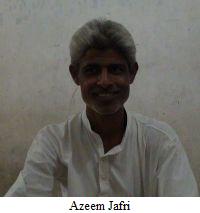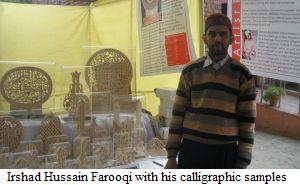Islamic Calligraphy: In search of a lifeline
Islamic Calligraphy: In search of a lifeline
 By Inam Abidi Amrohivi, Copy Edited By Adam Rizvi, TIO: THE art of Islamic calligraphy finds its roots in early Islam. Part of its popularity lay in the way the Quran stresses the importance of the written word. In Surah 96 (verse 3 to 4), God is described as one Who “taught man with the pen”. The Surah 68 starts with the oath, “And by the Pen”. Several other Suras are talking about writing, viz., Surah 96 (verse 3 to 4), Surah 82 (verse 10), Surah 50 (verse 16). Naturally, the best style of writings was developed for God. As Arabic became the language of all Muslims in Arabia and elsewhere, it gave birth to beautiful new forms of Arabic script.
By Inam Abidi Amrohivi, Copy Edited By Adam Rizvi, TIO: THE art of Islamic calligraphy finds its roots in early Islam. Part of its popularity lay in the way the Quran stresses the importance of the written word. In Surah 96 (verse 3 to 4), God is described as one Who “taught man with the pen”. The Surah 68 starts with the oath, “And by the Pen”. Several other Suras are talking about writing, viz., Surah 96 (verse 3 to 4), Surah 82 (verse 10), Surah 50 (verse 16). Naturally, the best style of writings was developed for God. As Arabic became the language of all Muslims in Arabia and elsewhere, it gave birth to beautiful new forms of Arabic script.

Prophet Muhammad’s son-in-law and the fourth Caliph of Islam, Ali ibn Abi Talib is considered to be the first master of calligraphy. He developed a Kufic script where the tops of alifs were twin-horned. [1] The Kufic in general is an angular script found on tombstones and coins.
The sacred nature of calligraphy ensured that in Islamic architecture inscriptions became an important means of decoration. Beautiful Islamic inscriptions soon adorned mosques, madrasas, mausoleums, and shia imambaras. The art was gradually extended to other secular texts.
Also, Read: Vajpayee And Jaswant Were Friends But Could Differ Like Gentlemen
Calligraphy in India flourished during the Mughals and later on found patronage with the Nawabs of Awadh. The evidence of the earliest Arabic inscriptions on structures of the 8th century has been found in India at Deybal (Sind), which is now in Pakistan. [2]
 Unfortunately, Islamic calligraphy is a dying art in India with very few people left practicing it full time. Traditional calligraphy is the worse hit. Laments Saiyed Anwer Abbas, a Lucknow based historian, “The present state of calligraphy is not healthy for traditional calligraphy (by pen) since the advent of calligraphy and inscription by computer. There is some scope in ‘Tughra-nawisi’ because the calligrapher presents new designs (Tughra) according to his ideas and imagination. Now, with knowledge of Urdu script becoming scarce in India, even the scope of tughra-nawisi is not bright.”
Unfortunately, Islamic calligraphy is a dying art in India with very few people left practicing it full time. Traditional calligraphy is the worse hit. Laments Saiyed Anwer Abbas, a Lucknow based historian, “The present state of calligraphy is not healthy for traditional calligraphy (by pen) since the advent of calligraphy and inscription by computer. There is some scope in ‘Tughra-nawisi’ because the calligrapher presents new designs (Tughra) according to his ideas and imagination. Now, with knowledge of Urdu script becoming scarce in India, even the scope of tughra-nawisi is not bright.”
Also, Read: Ostracism Of Indian Muslims
Abbas is not alone, renowned Lucknow based calligraphy artist Hashim Akhtar Naqvi (credited with inscribing ‘Bismillah-Ir-Rehman-Ir-Raheem’ in over 6,000 calligraphic designs ), echoes similar sentiments, “My exhibitions of Bismillah-Ir-Rehman-Ir-Raheem indeed draw huge crowds at all venues in India, but till date, not even a single person approached me to learn calligraphy.” He feels the government is also not very keen to revive the art and he is not willing ‘to go out of the way to seek government assistance.’
Ghalib Academy (Hazrat Nizammudin), New Delhi, has stopped its two-year program in Urdu Calligraphy.
Also, Read: Karbala: A Guiding Light for Humanity and the Essence of Islam
 MT had a first-hand experience of this rare art at the house in Lucknow of another calligrapher, Azeem Jafri. A painter by profession, Jafri, mixes calligraphy skills with his work. He’s very passionate about the art and feels it’s a pious and ‘halal’ way to earn money. Jafri is training both his children (a son and a daughter) to carry on his legacy. He told MT that people don’t value his creations on paper. “Some people give me Rs 500 for a sample, few art lovers from outside even pay Rs 5000, but most think it’s all worth only Rs 300,” says Jafri with a touch of sadness.
MT had a first-hand experience of this rare art at the house in Lucknow of another calligrapher, Azeem Jafri. A painter by profession, Jafri, mixes calligraphy skills with his work. He’s very passionate about the art and feels it’s a pious and ‘halal’ way to earn money. Jafri is training both his children (a son and a daughter) to carry on his legacy. He told MT that people don’t value his creations on paper. “Some people give me Rs 500 for a sample, few art lovers from outside even pay Rs 5000, but most think it’s all worth only Rs 300,” says Jafri with a touch of sadness.
Irshad Hussain Farooqi is a rare craftsman who practices calligraphy on wood. In general, Calligraphy is two dimensional, however, with the efforts of people like Farooqi, producing it on wood makes it three dimensional. He plans to set up an institute of calligraphy in India. He’s currently rebuilding his workshop in Delhi which he plans to use for imparting calligraphic lessons also. He is keen to take his designs to the Dubai International Exhibition for Arabic Calligraphy but needs help on that front. “I want to do much more for calligraphy in India but so far I’m unable to reach the right people,” informs Farooqi.
Also, Read: Brave Women Of Karbala
The Musalman is one of a kind (evening) newspaper. It is handwritten by calligraphers before being mass-produced. The paper was founded in 1927 by Syed Azmathullah. Its office is located at the Triplicane High Road in Chennai. Despite all obstacles, the newspaper has managed to survive this long. MT contacted their office for more insight but was politely declined, “We don’t give interviews to anybody.” We don’t mind until this unique tradition continues.
Notes
1 Prof. Annemarie Schimmel, Islamic Calligraphy (Institute of Religious Iconography, State University Groningen, Leiden E. J. Brill, 1970, Netherlands), 3.
2 Saiyed Anwer Abbas, Lucknow Ki Lupt Hoti Kalayen, Hamara Lucknow Pustakmala Series (Hindi Vangmaya Nidhi, 2012)
Complied and Curated by Humra Kidwai
First Published in Muslims Today



